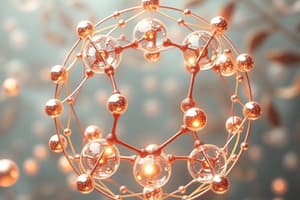Podcast
Questions and Answers
Explain the relationship between valence electrons and the octet rule in the formation of ions.
Explain the relationship between valence electrons and the octet rule in the formation of ions.
Atoms gain or lose valence electrons to achieve a full outer shell (octet), resulting in a stable ion with a noble gas electron configuration.
Considering the properties of ionic compounds, why are they typically solids at room temperature, while molecular compounds can be gases, liquids, or solids?
Considering the properties of ionic compounds, why are they typically solids at room temperature, while molecular compounds can be gases, liquids, or solids?
Ionic compounds have strong electrostatic attractions between ions, requiring more energy to break, hence higher melting points and solid-state at room temperature.
How does the chemical formula of an ionic compound, such as $MgCl_2$, reflect the electrical neutrality of the compound?
How does the chemical formula of an ionic compound, such as $MgCl_2$, reflect the electrical neutrality of the compound?
The ratio of Mg to Cl ensures that the total positive charge from the magnesium ions ($Mg^{2+}$) equals the total negative charge from the chloride ions ($Cl^−$), resulting in a neutral compound.
Explain why a polyatomic ion acts as a single unit in forming ionic compounds.
Explain why a polyatomic ion acts as a single unit in forming ionic compounds.
If element X readily forms a 2+ cation and element Y readily forms a 1- anion, what is the most likely chemical formula of the ionic compound formed between X and Y?
If element X readily forms a 2+ cation and element Y readily forms a 1- anion, what is the most likely chemical formula of the ionic compound formed between X and Y?
Describe how the formation of a cation and an anion leads to the formation of an ionic bond.
Describe how the formation of a cation and an anion leads to the formation of an ionic bond.
How does the number of valence electrons in an atom relate to its tendency to form an ionic bond?
How does the number of valence electrons in an atom relate to its tendency to form an ionic bond?
Explain why ionic compounds conduct electricity when dissolved in water but not in their solid-state.
Explain why ionic compounds conduct electricity when dissolved in water but not in their solid-state.
Flashcards
What is a cation?
What is a cation?
A positively charged ion formed by losing electrons.
What is an anion?
What is an anion?
A negatively charged ion formed by gaining electrons.
Valence Electrons
Valence Electrons
Electrons in the outermost energy level of an atom.
Octet Rule Definition
Octet Rule Definition
Signup and view all the flashcards
Ionic Bond
Ionic Bond
Signup and view all the flashcards
Ionic vs. Molecular Formula
Ionic vs. Molecular Formula
Signup and view all the flashcards
Polyatomic Ion
Polyatomic Ion
Signup and view all the flashcards
Ionic Formula Meaning
Ionic Formula Meaning
Signup and view all the flashcards
Study Notes
- A neutral atom loses one or more electrons, forming a cation
- A calcium atom becomes a calcium cation by losing two electrons: Ca -> Ca2+ + e- + e-
- A neutral atom gains one or more electrons, forming an anion
- An oxygen atom becomes an oxide anion by gaining two electrons: O + e- + e- -> O2-
- Valence electrons are higher in energy and in the outermost occupied energy level, but otherwise, the same charge and mass as any other electron
- Number of valence electrons in a neutral atom
- Na: 1
- N: 5
- Ar: 8
- Mg: 2
- S: 6
- Cl: 7
- Predicted charge of an atom based on the octet rule
- Na: 1+
- N: 3-
- Ar: 0
- Mg: 2+
- S: 2-
- Cl: 1-
- Ionic bonds hold atoms together because oppositely charged cations and anions attract one another
- Ionic compounds show a metal (or NH4+) ion at the beginning, while molecular compounds show only 2 nonmetals
- A polyatomic ion is multiple atoms, bonded together, that function as an individual ion
- The chemical formula for an ionic compound tells the ratio of cations to anions in the larger crystal lattice structure
- Ionic compounds are electrically neutral because the ratio of cations to anions will always be such that the positive charges exactly cancel the negatives
- A compound that is a liquid at room temperature, has a melting point of -25°C, and does not conduct electricity is most likely made of molecules because its low melting point suggests that it is not a solid at room temperature
Studying That Suits You
Use AI to generate personalized quizzes and flashcards to suit your learning preferences.
Related Documents
Description
Explore ion formation through electron gain or loss, creating cations and anions. Understand valence electrons, their role in bonding, and predicting ionic charges using the octet rule. Learn about ionic bonds and how to identify ionic compounds.



